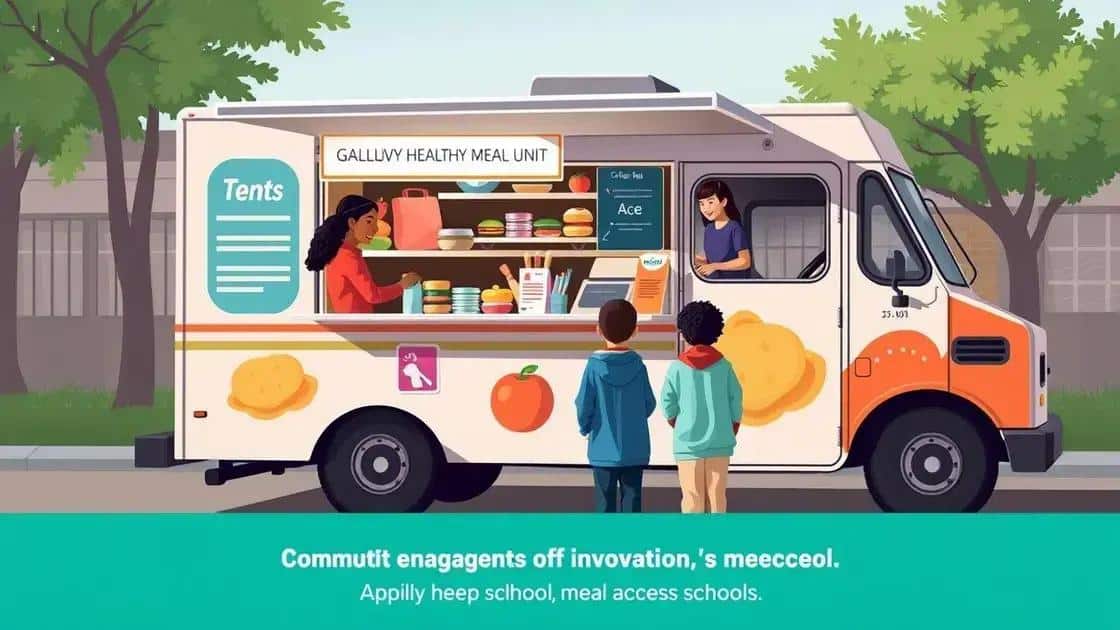Lead student meal access: enhancing nutrition for all

Lead student meal access ensures that all students have the nutrition they need for academic success, addressing food insecurity through innovative programs, community engagement, and technology integration.
Lead student meal access plays a crucial role in ensuring that every student has the nourishment they need to thrive academically and socially. Have you ever wondered how equitable meal programs impact student health? Let’s dive into this important topic.
Understanding lead student meal access
Understanding lead student meal access is key to promoting healthy eating habits among students. It emphasizes the importance of providing all students with access to nutritious meals during the school day. This access supports not only students’ health but also their academic performance.
The Importance of Meal Access
When schools ensure meal access, they are addressing several critical issues. For many students, school meals constitute a significant part of their daily nutritional intake. By providing these meals, schools can help combat food insecurity.
Key Benefits of Meal Access
- Improving student concentration and performance in classes.
- Reducing health disparities among different socio-economic groups.
- Encouraging students to develop lifelong healthy eating habits.
- Fostering a supportive school community that values every student’s well-being.
Furthermore, understanding the barriers to lead student meal access can guide schools in offering better programs. Some challenges include lack of funding, food supply issues, and awareness among families about available services. Addressing these barriers will ensure that every student can benefit from nutritious meals.
To enhance meal access, many schools are adopting innovative strategies. These include community partnerships, streamlined menus, and outreach programs to raise awareness among families. When schools engage with local businesses and organizations, they can create more sustainable meal programs that directly benefit students.
Community Involvement
Community involvement is essential for successful meal access programs. Engaging parents, students, and local organizations can help create a more robust support system. This collaboration often leads to more tailored meal programs that meet the specific needs of the student population.
Ultimately, understanding lead student meal access means recognizing its role in nurturing a healthier generation. By providing students with consistent access to nutritious meals, schools can greatly impact their overall well-being and academic success.
Importance of equitable meal access
The importance of equitable meal access cannot be overstated. It ensures that all students, regardless of their background, receive the nutrition they need for healthy development. This access is crucial for fostering a supportive learning environment.
Why Equitable Meal Access Matters
When all students have access to nutritious meals, it promotes health equity. Not every family can provide healthy food options. Therefore, schools act as a safety net, helping to fill in these gaps. Providing equal access to meals helps all students concentrate and learn.
Benefits of Equitable Meal Access
- Supports academic performance by providing essential nutrition.
- Reduces long-term health issues related to poor diet.
- Encourages social inclusion among students of different backgrounds.
- Helps parents focus on other responsibilities without worrying about meal preparation for their children.
Moreover, equitable meal access cultivates a sense of community in schools. When students gather to eat together, they build relationships and enhance cooperation. It plays a role in teaching kids about nutrition, sharing, and caring for one another.
Schools can implement programs to ensure that all students benefit from equitable meal access. Programs like free lunch initiatives and food pantries create opportunities for those who may struggle to afford meals. At the same time, education on healthy eating habits can help students make better choices.
Strategies for Success
To successfully promote equitable meal access, schools should consider several strategies. These may include establishing partnerships with local farms, increasing awareness of available resources, and advocating for funding. Support from the community is essential to strengthen these initiatives.
Incorporating student feedback also enhances the effectiveness of meal programs. Understanding what students enjoy will lead to better participation. Ultimately, all these efforts aim to ensure that every child has the nourishment to thrive.
Innovative programs supporting meal access

Innovative programs play a vital role in supporting meal access for students. These programs are designed to address the unique needs of communities and ensure that every student receives nutritious meals during the school day.
Types of Innovative Programs
Many schools have implemented creative strategies to improve meal access. One popular approach is the adoption of mobile feeding units. These units bring meals directly to students in remote areas, making use of technology to reach those in greatest need.
Key Features of Successful Programs
- Personalized meal planning based on student preferences.
- Partnerships with local farms to source fresh ingredients.
- Utilization of technology for easy access and communication.
- Community volunteers helping prepare and distribute meals.
Moreover, after-school meal programs have gained attention for their effectiveness. These initiatives provide students with healthy snacks or dinners after the school day ends, targeting those who might not have access to food at home. By ensuring that students have meals outside regular hours, schools can further support academic success.
Alongside these, implementing nutrition education is crucial. Programs that teach students about healthy eating choices empower them to make better decisions. When students understand the importance of nutrition, they are more likely to participate in meal programs.
Successful Case Studies
Numerous case studies highlight the success of these innovative programs. Schools that partnered with local chefs to create unique, appealing menus saw an increase in meal participation. This not only improves student health but also makes meals something to look forward to.
Additionally, technology-based solutions, such as apps that allow parents to track meals and provide feedback, have enhanced community involvement. By fostering a sense of connection, these programs encourage greater participation and support.
Challenges in implementing meal access systems
Implementing meal access systems faces several challenges that can impact student nutrition. These obstacles can arise at various levels, from funding issues to logistical hurdles.
Common Challenges
One of the most significant challenges is securing adequate funding. Schools often rely on government programs and grants, which may not cover all expenses. This limitation can affect the quality and variety of meals offered to students.
Logistical Issues
Logistics also play a crucial role in meal access. Delivering fresh ingredients to schools in a timely manner can pose difficulties, particularly in rural areas. Ensuring that meals are prepared and served at the right temperatures is essential for food safety and quality. Additionally, some schools lack adequate kitchen facilities, which hinders their ability to provide nutritious meals.
- Inconsistent meal quality due to lack of resources.
- Limited staff to prepare and serve meals.
- Inadequate food storage options.
Another challenge includes reaching students who may need meal access the most. For instance, students who attend schools in low-income areas might not have the same access to nutritious meals compared to those in wealthier districts. This disparity highlights the need for targeted outreach programs to ensure that all students know about available resources.
Meal access systems must also navigate regulatory requirements. Compliance with state and federal nutrition guidelines can be complex. Schools must stay informed about changing regulations, which can impact meal planning and offerings.
Community Support
Building community support is essential for overcoming these challenges. Engaging parents and local businesses can create a stronger support network. When communities work together, they can advocate for better funding and resources for schools.
By understanding the challenges in implementing meal access systems, we can begin to identify solutions that will help ensure that all students receive nutritious meals. Through collaboration and community involvement, these obstacles can be addressed effectively.
Future of meal access initiatives
The future of meal access initiatives looks promising as communities increasingly recognize the importance of nutrition in education. Innovators are developing new strategies to ensure every student has access to healthy meals.
Emerging Trends
One emerging trend is the integration of technology into meal programs. Apps and online platforms are being used to streamline meal requests and enhance communication between schools and families. This simplifies the process for parents and ensures that students get the meals they need.
Personalized Meal Options
Another direction for the future is offering personalized meal options. Schools are beginning to assess individual dietary needs and preferences, allowing students to select meals that suit their tastes and nutritional requirements. This approach not only improves meal participation but also promotes healthier eating habits.
- Increased focus on plant-based options for sustainability.
- Collaborations with local food producers to enhance freshness.
- Programs addressing specific dietary restrictions, such as allergies.
Along with this, community involvement will continue to play a vital role. Local organizations and businesses can partner with schools to expand resources and support diverse meal programs. Engaging parents and students in meal planning encourages greater buy-in and awareness.
Policy changes are also likely to shape the landscape of meal access initiatives. Supportive legislation can provide funding and establish guidelines that help expand meal access and ensure quality. Advocates are pushing for more comprehensive legislation that addresses food insecurity at the national level.
Looking Ahead
As society evolves, so too will the approaches to ensuring meal access for all students. Schools will need to adapt to changing nutritional standards and cultural diversity within their student populations. Continuous innovation and collaboration will be key in creating effective meal access strategies.
Ultimately, the future of meal access initiatives holds the potential to transform how students experience food in schools. By addressing these factors, we can cultivate a generation that values healthy eating habits and understands the importance of nutrition in their lives.
meal access initiatives are crucial for ensuring all students receive the nutrition they need to succeed. By overcoming challenges and embracing innovative solutions, schools can create equitable meal programs. Community support, technology integration, and personalized options will play a significant role in shaping these initiatives in the future. Together, we can foster a healthier generation that values good nutrition and understands its importance in their lives.
FAQ – Frequently Asked Questions about Meal Access Initiatives
Why is meal access important for students?
Meal access is crucial as it ensures that all students receive the nutrition they need to perform well academically and maintain their health.
What are some common challenges in implementing meal access programs?
Common challenges include securing adequate funding, logistical issues in food delivery, and ensuring compliance with dietary regulations.
How can technology improve meal access initiatives?
Technology can streamline meal requests, enhance communication between schools and families, and help manage meal planning effectively.
What role does community support play in meal access programs?
Community support is vital as it helps expand resources, engages families, and advocates for better funding and initiatives for schools.






